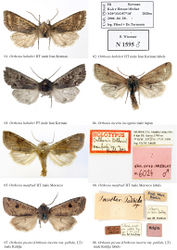Difference between revisions of "Orthosia habeleri"
m (Imported from Nota Lepidopterologica) |
m (1 revision imported) |
(No difference)
| |
Latest revision as of 16:27, 13 February 2020
| Notice: | This page is derived from the original publication listed below, whose author(s) should always be credited. Further contributors may edit and improve the content of this page and, consequently, need to be credited as well (see page history). Any assessment of factual correctness requires a careful review of the original article as well as of subsequent contributions.
If you are uncertain whether your planned contribution is correct or not, we suggest that you use the associated discussion page instead of editing the page directly. This page should be cited as follows (rationale):
Citation formats to copy and paste
BibTeX: @article{Wiesmair2020NotaLepidopterologica43, RIS/ Endnote: TY - JOUR Wikipedia/ Citizendium: <ref name="Wiesmair2020Nota Lepidopterologica43">{{Citation See also the citation download page at the journal. |
Ordo: Lepidoptera
Genus: Orthosia
Name
Orthosia habeleri Wiesmair & Shirvani & Ronkay, 2020 sp. nov. – Wikispecies link – ZooBank link – Pensoft Profile
Type material
Holotype. Male, Iran, Kerman, Kuh-e-Hessar/Abshar, 2820 m, 29°33’N, 57°18’E, 28.iv.2006, leg. B. Plössl & G. Tarmann; slide No. N1595 (coll. TLMF, Hall in Tyrol).
Paratype. Male, Iran, Kerman, Jiroft, Mardehak, 2273 m, v.2009, leg. M. Shoghali; slide No. AS532 (coll. Shahid Bahonar University, Kerman).
Taxonomy
The new species belongs to the incerta-lineage, its closest known relative is the Moroccan O. manfredi, due to the progressive series of similar morphological reductions in the male genitalia (reduction of the pollex, and the shortened carinal thorn or the rather straight aedeagus). On the other hand, there are a number of easily recognisable specific external and male genital features which distinguish the three closely related species, O. habeleri, O. manfredi and O. incerta.
Diagnosis
The male genitalia of the new species (Figs 25, 26) can be distinguished from those of O. incerta and O. manfredi (Figs 27–30) by the 1) subapically stronger dilated, apically more tapering uncus (it is the widest medially while the broadest part is the apical section in the two close relatives); 2) the more elongated valva with distally less curved costa; 3) the larger and apically broader, rounded cucullus; 4) the basally straighter, medially less curved, rather arched thorn-like ampulla; and 5) the much stronger, longer and thicker erect part of the harpe (clasper). The rather straight aedeagus and the shortened carinal thorn of O. habeleri is closer to those of O. manfredi than to O. incerta but the basal part of the carinal thorn of the new species has a broader junction plate and is more divergent from the main tube of the vesica than in the other two relatives. The aedeagus of O. incerta is longer and more arched than in the two other sister taxa and the carinal thorn is remarkably longer than in O. habeleri and O. manfredi.
Description
Wingspan 36–37 mm (holotype: 36 mm; paratype 37 mm), length of forewing 16 mm. Ground colour of the two known specimens conspicuously different (see the Figs 1–3), varying from ochreous-brown to smoky-greyish with black irroration. Eyes large, hairy; palpi rather slender; male antennae biserrate with short fasciculate cilia. Pubescence of head, collar, tegulae and thorax unicolorous. Forewing relatively narrow, apically pointed, outer margin slightly sinuous. Forewing markings very variable in the two individuals, elements of noctuid pattern less distinct, basal two-thirds of costal margin paler than ground colour; basal dash present, short, black; antemedial line obsolescent; postmedial line better visible, dark blackish-grey; median area somewhat darker than ground colour. Orbicular and reniform stigmata present, their filling slightly paler than median area, their outlines rather distinct, blackish-grey; claviform stigma obsolete. Subterminal line distinct, waved, defined by dark grey scales in tornal and median areas; terminal line fine, whitish-ochreous; terminal area and fringes as ground colour, fringes finely spotted with darker scales and fine blackish medial line. Hindwings whitish-ochreous, suffused strongly with darker ochreous-brown to brownish grey; discal spot and tornal patch darker brown-grey; terminal line fine, dark grey-brown; fringe somewhat darker than ground colour; abdomen dark brown, without distinctly coloured lateral ridges and dorsal crest, basal abdominal brush organ („trifine brush organ”) absent. Male genitalia (Figs 25, 26). Genital capsule symmetrical, strongly sclerotized. Tegumen narrow and high; valvae elongated, costal margin weakly S-shaped; sacculus long, sclerotized; clavus large, rounded; harpe broad, with short, erect digitiform process; ampulla long, almost straight or somewhat arched thorn-like (right ampulla of the holotype is broken, that is complete in the paratype), its basal half wider, tapering apically; cucullus large, basally straight; pollex and corona absent. Uncus scaphoidal, basally cylindrical, subapically dilated, tapering apically; juxta long and strong, quadrangular; vinculum very long, pointed, V-shaped. Aedeagus cylindrical, long and rather straight; carina with long, sclerotized, pointed thorn. Vesica tubular, recurved, bearing a small subconical diverticulum in basal half.
Female genitalia. Unknown.
Bionomics and distribution
The species is known from the regions of high elevation of the southern Zaghros Mts (the two specimens were collected above 2200 m elevation). The biology is poorly known, but the flight period is in late spring (April–May), similar to several other species of the genus.
Etymology
The new species is dedicated to Heinz Habeler (Graz, Austria), who was the mentor providing enthusiastic help and motivation to the first author.
Original Description
- Wiesmair, B; Shirvani, A; Ronkay, L; 2020: A new Orthosia Ochsenheimer, 1816 species from Iran (Lepidoptera, Noctuidae, Hadeninae) Nota Lepidopterologica, 43: 15-28. doi
Images
|

